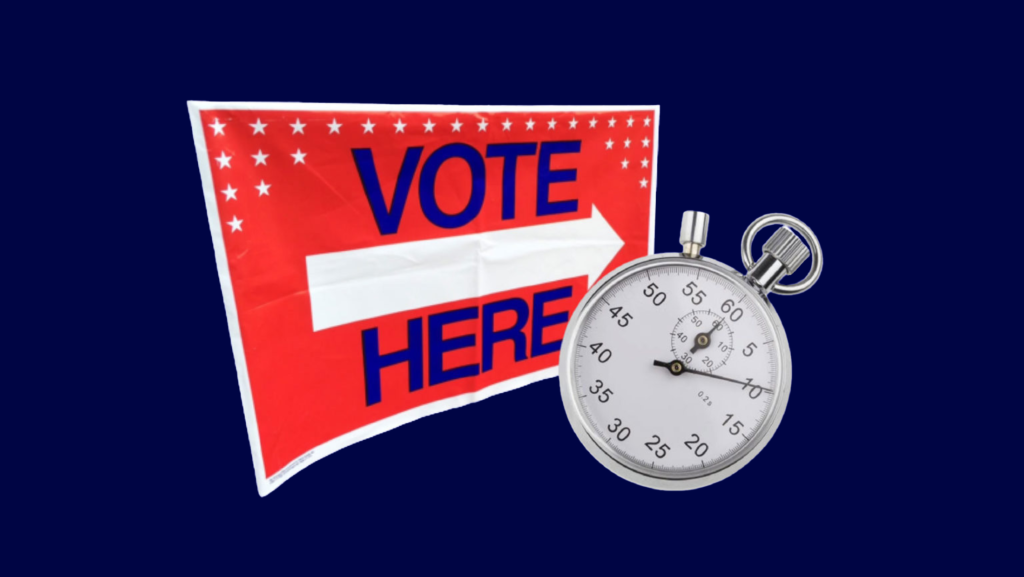A Simple Solution to Long Voting Lines: 30 Minutes or Less

When it comes to voting rights, Republicans claim to be misunderstood. They insist they are not trying to suppress the vote; they just want to make voting more secure. For Republicans that means promoting in-person voting.
Even though I vehemently disagree with Republicans’ undermining of vote by mail, I am all for expanding access to in-person voting. So, in the spirit of bipartisanship, I want to propose a legislative reform that meets Republicans’ stated objective of encouraging in-person voting. States should pass laws prohibiting long lines at the polls. Specifically, states should prescribe by law that no voter should have to wait more than half an hour in order to cast a ballot.
Here is how it would work. The new law would entitle voters to a wait time of 30 minutes or less when voting in person. If the state or a locality fails to meet this time limit, it must pay the affected voter for the time the voter spent waiting in line in excess of 30 minutes.
Voters could seek the actual cost to them of waiting in line (lost wages, childcare, etc.) or accept an hourly minimum that each state could set by law. If there was a dispute over the length of a wait or the cost of a voter’s time, it would be resolved in an expedited court proceeding. The state would owe the legal fees and costs of any prevailing voter plaintiff as well as the costs of the plaintiff’s own time in bringing the lawsuit.
Why 30 minutes? That was the time limit that the bipartisan Presidential Commission on Election Administration in 2014 announced should be the “general rule.” After studying the problem for months, it determined that “[a]ny wait time that exceeds this half-hour standard is an indication that something is amiss and that corrective measures should be deployed.”
Requiring election officials to pay when voters wait in long lines will have several benefits.
For one, it will provide some relief to those waiting in long lines to help defray the economic costs of voting in person. Money alone may not sufficiently compensate voters forced to choose between exercising their fundamental right to vote and providing for their family, but it may go a long way toward recognizing the burdens imposed on these voters. It will also give voters some sense of empowerment — the feeling that they no longer have to wait helplessly in long lines to vote without any recourse.
This system will also help us better understand the true cost and scope of the problem by putting a dollar value to it. Most importantly, it will incentivize states and localities to prevent long lines in the first place.
To be clear, long voting lines are not inevitable or unavoidable. They are the product of policy choices states and counties make as to whose time — and whose vote — is valuable and whose is not.
The data consistently shows that states and counties provide the equipment, space and personnel necessary to avoid long lines in predominately white communities while failing to do so in predominantly minority communities — even when both communities are located in the same geographic area and have similar governmental resources.
For example, using cell phone tracking data, a study of the 2016 election showed that residents of entirely Black neighborhoods waited 29% longer to vote than their counterparts in entirely white neighborhoods. Most tellingly, this disparity held up even within the same counties — many of which were among the wealthiest counties in the country.
Another study of 2018 election wait times found that “Latino voters waited on average 46 percent longer than white voters, and Black voters waited on average 45 percent longer than white voters.” Importantly, the authors of this study noted that “the 2018 racial wait gap cannot be explained by the level of resources per voter in counties populated largely by racial and ethnic minorities. In fact, whiter counties tended to have fewer resources per voter than less-white counties.”
Finally, in a lawsuit over long lines in heavily Black areas of the metro-Atlanta counties during the 2020 primary, Stanford Political Science Professor Jonathan Rodden found that “where minorities constituted more than 90 percent of active registered voters, the average minimum wait time in the evening was 51 minutes. When whites constituted more than 90 percent of registered voters, the average was around six minutes.”
When President Obama announced the creation of the Presidential Commission on Election Administration during his 2013 State of the Union Address, he declared, “[w]hen any American, no matter where they live or what their party, [is] denied that right [to vote] because they can’t afford to wait for five or six or seven hours just to cast their ballot, we are betraying our ideals.” He vowed: “We can fix this and we will. The American people demand it. And so does our Democracy.”
President Obama was right that we can fix the problem of wait times for voting. But we have not.
States did not fix this problem when they were passing laws to impose onerous ID requirements or to restrict vote by mail. Counties did not fix this problem when they were closing polling locations or allocating new voting equipment. And Congress did not fix this problem even as a pandemic was devastating minority communities in the midst of a national election.
If Republicans genuinely believe that providing access to in-person voting is key to a healthy democracy, now is the time for them to support this simple solution.
This is no time to wait.